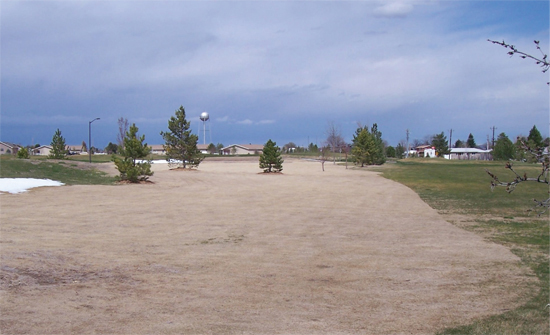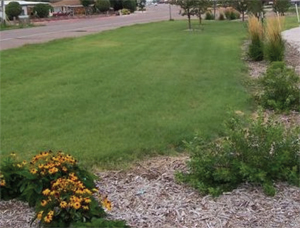G1947
Management of Buffalograss Turf in Nebraska
This NebGuide is the second in a two-part series on buffalograss and covers the proper management of buffalograss turf. Buffalograss is a low-maintenance turf, but it still requires irrigation, mowing, fertilization, and weed control after the turf is established.
James A. Schild, Extension Educator
Roch E. Gaussoin, Extension Turfgrass Specialist
Robert C. Shearman, Extension Turfgrass Specialist
|
Introduction
Most turf managers and home owners feel comfortable managing cool-season turfgrasses such as Kentucky bluegrass and tall fescue. Buffalograss (Figure 1), however, is a warm-season grass. Managing buffalograss like Kentucky bluegrass will result in a turf that is weedy and in poor vigor. The buffalograss turf manager needs to rethink the timing of several elements:
- irrigation;
- fertilizer;
- mowing;
- weed control;
- insects; and
- diseases.
Irrigation
Buffalograss lawns in eastern and central Nebraska usually can be maintained with no irrigation beyond precipitation, after the establishment year. In the western part of the state, some irrigation is needed to keep the turf green and actively growing. Early-season irrigation in April and May will not bring buffalograss out of dormancy. It will, however, increase cool-season weed growth in the turf. Delaying the first irrigation until the turf begins to green up will ensure a vigorous, dense lawn that is competitive with weeds.
The greatest benefit from supplemental water is gained in late July through August, during the period of active stolon growth. Irrigation applied at this time to new stands helps stolons develop roots at the nodes, thus establishing new plants and increasing stand density. Unfortunately, irrigation at this time will also promote weed growth. The period of time in which the turf exhibits a green color may be moderately extended in the fall with additional water if freezing temperatures do not occur.
Fertilizer
For optimum results, apply fertilizer between June 15 and July 15. Split applications a month apart to get the best response. Fertilizer applied earlier than this time stimulates weed growth and will not cause the buffalograss to break dormancy at an earlier date. Fertilizing in mid-June stimulates new tissue and fertilizer applied now also will be available during the period of active stolon development in July and August. In most cases one-half to 1 lb of nitrogen per 1,000 square feet is appropriate for a low-to-medium maintenance turf. Actual nitrogen levels should not exceed 2 lb per 1,000 square feet per year.
Buffalograss responds better to quick-release forms then to slow-release forms of fertilizers. When choosing a fertilizer, look for formulations that are high in quick-release nitrogen sources, such as urea.
Mowing
Buffalograss is a naturally short-growing grass with a maximum height of 4 to 5 inches. Buffalograss lawns can be mowed to 3 to 4 inches to remove the slender male flower stalks that develop above the height of the leaves in seeded cultivars. This may require regular mowing, since the male flowers are continually produced. Female cultivar selections may require less mowing, since the female flower is found in the canopy.
Buffalograss turf can be given a uniform appearance by mowing at 2.5 inches every three to four weeks in late spring and early fall and every two to three weeks later in the summer. Improved cultivars of buffalograss can be mowed at lower heights (one-half to 1 inch) for golf course fairway use. These lower heights will require more frequent mowing and increased management to maintain quality.
Mowing management influences the amount of supplemental water needed to maintain a green turf and good stand quality. Minimal mowing and higher cutting heights will allow buffalograss to maintain a vigorous root system. Removing more than one-third of the leaf material will reduce root activity and growth, making plants more susceptible to stresses. Buffalograss may require edging along walks, driveways, shrubs and flower beds due to aggressive stolon development. Do not cut the grass by more than one-third its total height at any one mowing.
There is an alternative to mowing: allow the grass to develop seed heads and add spring flowering bulbs and wildflowers to give the landscape a naturalistic look.
Weed Control
Once a stand is established and properly managed, weed pressure in buffalograss is minimal. Avoid broadleaf herbicide use in the spring green-up period in mid- to late May. Herbicides applied at this time, even though labeled for use on buffalograss, may cause some plant injury that could last season-long. If herbicides are required, follow label directions explicitly. Dimension® (dithiopyr), Barricade® (prodizmine), and Pendulum® (pendimethalin) are labeled for use in buffalograss. A spring application for control of summer annual weeds — crabgrass, goosegrass and spurge — should be applied when soil temperature reaches 55°F. A second preemergence application in late summer or early fall will control winter annuals, such as henbit, chickweed, and annual bluegrass. Follow label directions to determine if the herbicide needs to be incorporated with rainfall or supplemental irrigation.
Postemergence control of annual grasses is best achieved with quinclorac (Drive®) or arsenical compounds (DSMA, MSMA). Broadleaf products cleared for use in buffalograss include a number of 2,4-D-containing products. Do not apply products containing 2,4-D if you expect temperatures higher than 75°F on the day of application, because damage to the buffalograss could occur. Damage symptoms are a yellowing of the grass and stunted growth that could last weeks or season-long.
Dormant buffalograss can be sprayed with glyphosate (Roundup®) to control weeds (Figure 2). Fall applications can be applied after the first hard killing freeze or when the buffalograss turns straw-brown. Donít apply glyphosate if the buffalograss is showing any green color. Glyphosate applications applied to semi-dormant buffalograss will significantly delay green-up and could severely injure the buffalograss. To insure no injury, do not spray glyphosate (Roundup) after Feb 15 through two weeks after the first hard killing freeze (25°F) in the fall.
 |
| Figure 2. Dormant buffalograss golf course rough-sprayed with glyphosate (Roundup) to control cool-season grasses. Notice clean line created between buffalograss rough and Kentucky bluegrass. (Photo courtesy city of Gering, Ron Ernst and Tom Walsch.) |
Insects
In general, buffalograss is relatively free of insect and mite pests, possibly because established buffalograss usually harbors many beneficial insects that naturally control pest populations. These natural enemies include big-eyed bugs, syrphid flies, lady beetles, predatory mites and several species of parasitic wasps.
In Nebraska, the most serious pests of buffalograss are a tiny, grass-infesting mealybug, buffalograss webworm, and buffalograss chinch bug.
There are not, however, insecticides registered to control mealybugs or webworms in buffalograss. Control of these insects is through proper maintenance and cultural practices.
Diseases
Buffalograss is relatively free of plant pathogens. Isolated cases of diseases have been reported; however, little research has been done in this area. The most problematic disease may be Bipolaris leaf spot. Proper maintenance of buffalograss, and incorporating integrated pest management practices should reduce the likelihood of disease infestations.
The first in the series “Establishing Buffalograss Turf in Nebraska” discusses cultivar selection, converting Kentucky bluegrass to buffalograss, and establishment of buffalograss.
This publication has been peer reviewed.
Disclaimer Reference to commercial products or trade names is made with the understanding that no discrimination is intended of those not mentioned and no endorsement by University of Nebraska–Lincoln Extension is implied for those mentioned. |
Visit the University of Nebraska–Lincoln Extension Publications Web site for more publications.
Index: Lawn & Garden
Turf
Issued May 2009
